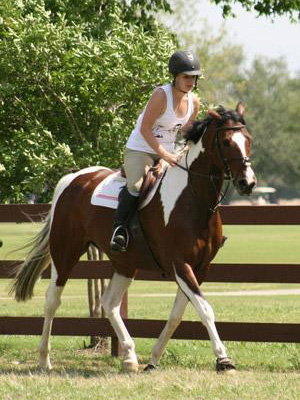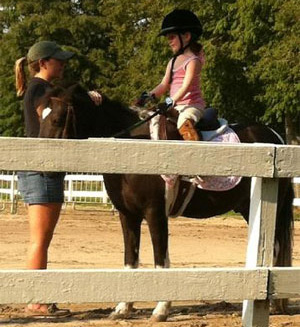Levels
The Equest Farm Riding School provides a safe and wholesome environment for beginner through advanced riders. The riding program has been carefully designed to progress riders through a structured curriculum, providing consistent step-by-step instruction across the program. An ongoing evaluation of the student's abilities allows for advancement at an individualized pace. Through this program students are able to develop into competitive riders, building confidence, motivation, discipline, coordination, focus and camaraderie, while still having fun and developing a compassionate bond with horses.
Along with riding skills, the riding school program incorporates safety procedures throughout the lessons. Safety at all times is our first priority.


Level 1:
First Evaluation lesson, little to no experience with horses.
Level 2:
Beginner Package, learning to steer, riding positions and how to trot.
The rider is learning to steer around the ring and over poles, working on posting and two-point.
Level 3:
Able to ride in a group, trotting confidently and trotting cross rails. Not yet tacking for themselves.
By now, the rider can steer around others and is able to trot a course of cross rails. The rider should be able to do this on at least 4-5 horses.
Required Attire:
- Helmet (ASME/FEI approved)
- Breeches (no jeans)
- Riding shirt or t-shirt tucked in to breeches
- Paddock or tall boots
- Hair neatly tied, under helmet
Level 4:
Learning diagonals, riding without stirrups, able to jump a course of cross rails. Tacking for themselves.
They need to be able to trot x’s with good corners, and good two-point. They will begin to learn to ride without stirrups. Riders CANNOT canter until they can post two laps around the ring with no stirrups and can confidently tack for themselves. It has to be done confidently, not poorly. It takes most riders 6 months to a year to get to level 5.
Required Attire (in addition to the above requirements):
- Half chaps
- Gloves
- Hair net (for girls)
Level 5:
Learning to Canter.
When they learn to canter, they do not canter all at once but one at a time in the group setting. They need to be able to canter on 3 different horses before they move on to level 6.
Level 6:
Able to canter confidently, cantering poles.
This is where they learn how to count canter strides. They are taught how to count to the pole, helping them see a distance to the pole. They do not move on until they can do this on 3 different horses.
Level 7:
Cantering cross rails.
Continue with counting and timing of two-point. They need to be able to canter a course and be successful more than 90% of the time. They should see their distance to the pole and start to understand when to whoa and when to go.
Level 8:
Small verticals.
The vertical needs to start on the first hole, the second fence in a line. This is a long slow process and should not be rushed. The student will slowly build up to jumping a line of small verticals, then start going up one hole higher.
Level 9:
Jumping 18" courses.
The student should be able to ride at least 5 different horses at this level. Their corners and equitation should be very strong.
Level 10:
Jumping 2'.
Level 11:
Jumping 2'3".
Level 12:
Jumping 2'6" courses.

